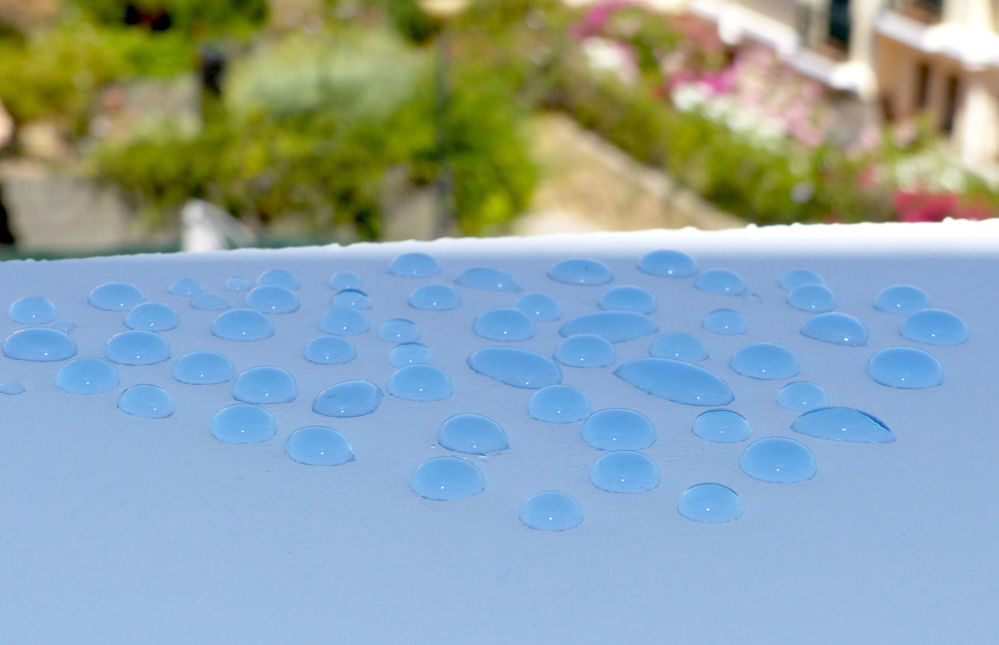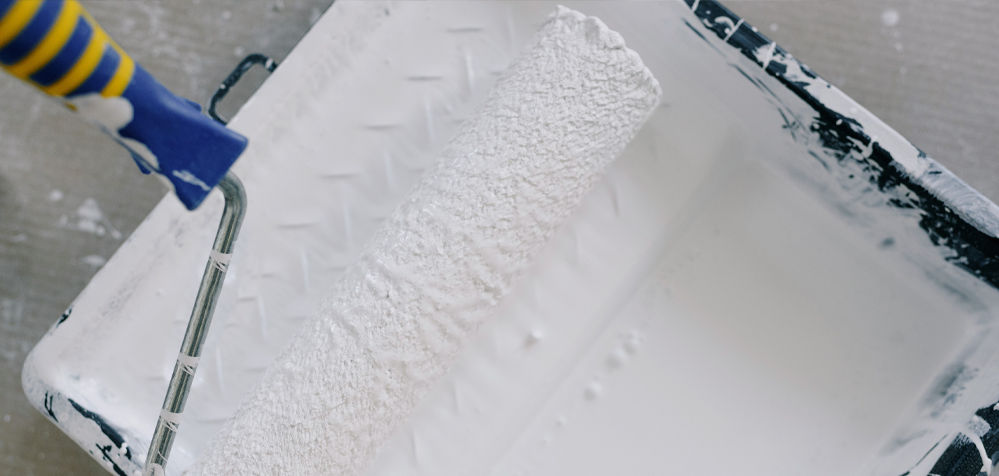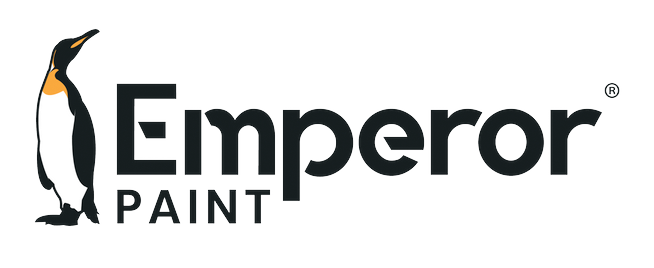
When the weather brightens up we all want to be able to get outside and enjoy our outdoor spaces. However, there are often a couple of jobs on our to-do-list before we can fully relax, whether it is paint the exterior walls of your house or simply revamp the garden fencing. One of the most common questions we get asked here at Emperor Paint is how to paint a exterior concrete, as there is a few common misconceptions regarding this. In any case, you want beautiful, long-term results that you know will stand the test of time, which is why our experts have put together this handy guide to painting exterior concrete walls, so you can find all the information you need in one place.
Painting Concrete
Concrete is a building material that is found all over the exterior of our houses, from exterior walls to patios. While in theory all paints that are suitable for use on concrete will adhere to the surface, this doesn't mean that every concrete paint is suitable for your project. A concrete wall has different requirements to a concrete patio, due to the fact that a concrete patio is a horizontal surface where water can pool. For this reason, it is crucial to carefully consider which paint you use when starting your project.
Due to the weathering that exterior surfaces must endure, you must also use a paint that can deal with exposure to wind and rain. Concrete as a mineral surface is porous, meaning it can absorb moisture. The more porous a surface, the more water it will absorb. While all exterior paints come with some level of weather protection, they are not all waterproof. This is why you will often see exterior paints labelled 'weatherproof' or 'weather resistant', as they are not completely waterproof. To be waterproof, a paint must be water repellent, as to prevent any moisture from absorbing into the concrete.
You may be asking, why is it important for a paint to be waterproof? The answer is simple, water is the single biggest cause of paint failure. When water absorbs into the painted concrete, it gets trapped in the material. This is especially the case with paints that have low breathability, as the paint has no where to escape. Eventually, the water causes the paint to start peeling and flaking, which can happen after a matter 1-3 years. Further to this, when exterior surfaces become saturated with moisture, this can lead to discolouration and the growth of lichens on the surface. By keeping exterior concrete dry, waterproof paint can prevent paint failure and keep the painted concrete looking pristine.
What Concrete Pant Is Suitable For Me?
So, which concrete paint is best for your project? When it comes to paint, it is always best to use one that is specifically designed for that surface. This ensures that the paint has the necessary properties for long-term performance when used in that way.
PAINTING CONCRETE WALLS
If you are looking to paint exterior concrete walls, you must use a masonry paint. These are paints that are designed for vertical masonry surfaces, whether they are concrete, brick, stone or render. Masonry paints come in different forms, which include acrylic masonry paint, silicone masonry paint and oil-based masonry paint
Acrylic masonry paint is what the majority of standard masonry paints in the UK are. These water-based formulations come with varying levels of weather protection, although they do suffer from low breathability. This can lead to any moisture that is absorbed by the coating getting stuck underneath the paint film, which is why acrylic masonry paints often come with a lifespan of 3-5 years.
Silicone masonry paint is a technologically advanced form of masonry paint that has added resins that create a water repellent & highly breathable surface on exterior walls. As water cannot soak into the surface, but can naturally breathe out, silicone masonry paint is extremely durable, often coming with a 20+ year lifespan. While not strictly a water-based paint, they are water-dilutable and can be cleaned using water.
Oil-based masonry paint, otherwise known as pliolite, is a traditional form of masonry paint which is designed to be applied in conditions below 5°C or to prevent the paint from washing off straight after application due to rainfall. While weather resistant, pliolite has a very low breathability, which is why it is generally only for use in certain commercial circumstances.
PAINTING CONCRETE PATIOS
When painting concrete patios, it is important to use a dedicated floor paint. Other exterior paints that can be applied to concrete such as masonry paint are not designed for foot traffic, which can lead to them peeling. Furthermore, floor paints have anti-slip additives in their formulation to help reduce the risk of people slipping when they walk on the surface, especially when it is wet. While it can be tempting to use a tin of masonry paint that you have at the back of the shed to revamp your patio, investing in an exterior floor paint that will stand the test of time is your best option.
Super Hydrophobic Technology
Due to the unpredictable weather we get here in the UK (thanks mother nature), ensuring the paint you use is waterproof is essential. That is why we developed our highly advanced super hydrophobic technology. The likelihood is that you haven't heard of super hydrophobic technology, but let us explain it in a little bit more detail.
Super hydrophobic surfaces repel water, causing it to form beads on the surface. Not only can water not attach itself to the super hydrophobic surface, but dirt also cannot stick. This means that any rainfall simply washes the dirt away, creating a self-cleaning surface. The benefits don't stop there, as by keeping concrete dry, no green growth or lichens can bloom on the painted concrete, meaning discolouration and staining is prevented. This all contributes to surfaces painted with super hydrophobic technology staying looking pristine for decades.

Emperor Masonry Paint is our specially designed silicone masonry paint which is suitable for use on any exterior walls, including concrete, stone, render or brick.
In independent 25 year weathering tests, Emperor Masonry Paint was found to prevent water absorption by 96%, remain highly breathable and after 25 years of heavy weathering, it showed no signs of change in appearance or performance. This 25-year proven performance was under harshest weather conditions possible, from freezing temperatures to extremely heavy rainfall. Due to this, Emperor Masonry Paint comes with a lifetime guarantee, ensuring its performance in all weather conditions without failing.
One of the most significant findings from the independent testing was Emperor Masonry Paint's ability to improve the heat retention of exterior walls. A brick wall left unpainted was found to be on average 6°C colder than the brick wall painted with Emperor Masonry Paint. For this reason, Emperor Masonry Paint has been verified by the Energy Saving Trust following their independent review process.
Emperor Masonry Paint comes in a specially curated colour palette, with 18 popular exterior shades. This includes neutrals such as White, Off-White, Light Grey & Witney Cream, with a number of other light and pastel shades that have been chosen for their unrivalled ability to transform outdoor spaces. Why not order hand-painted colour card and find the perfect colour for you?
How To Paint Exterior Concrete
As with any decorating project, ensuring you take the correct steps is essential for achieving beautiful, long-lasting results. Do not worry as our team of experts have put together their step-by-step guide to painting exterior concrete walls from start to finish.
YOU WILL NEED:
- Masonry paint
- Masonry roller (long-pile roller)
- Paint tray or scuttle
- Paint brush
- Dust brush
- 120 grit sandpaper
- Dust sheets
- Window film
- Masking tape
- Exterior filler & filling knife (may be required)
- Scraper (may be required)
PREPARATION
Preparation is the most important part of the decorating process, no matter the project as any professional decorator will tell you. It is crucially important to not rush this step as it can cost you in the long-run, either with a poor finish or failing paint.
The first step is to fill any cracks or holes in the concrete wall as this achieves a perfect finish and also ensures no water can enter the concrete once it is painted, helping to ensure the surface is water-tite. Remove any loose rubble from the defect before filling it, as you need a solid surface to fill. Using a good exterior filler such as the Toupret Masonry Repair Filler, fill the defect with a filling knife, pushing the filler back and forth until it has fully filled the space. It is sometimes worth overfilling the defect to allow for shrinkage when the filler dries. Once the filler has fully dried, sand this back using a 120-grit sandpaper to get a perfectly smooth surface ready to paint.
If you are painting concrete that has been previously painted, any areas peeling paint must be removed before you paint. Strip the paint back until you get a firm edge, where no more paint is coming off.
Once the surface is properly filled and sound, it is time to clean it. You must clean any surface before painting, but especially with exterior surfaces as these can become dirty due to all of the contaminants that can blow onto the surface. If you leave any dirt on the wall, this can cause the paint to not adhere to the concrete. Furthermore, any organic growth on the wall can bloom and cause the paint to fail when it grows underneath the paint film. You can clean concrete walls using a power washer or hose pipe. If you do not have one, you can use a stiff brush and hot soapy water. Concrete can have a tendency to gather ingrained dirt quite easily, so be prepared to really scrub the wall to get it nice and clean. Once this has removed the larger bits of dirt, you can apply a fungicidal cleaner such as Emperor Exterior Cleaner, which kills any organic growth. Simply apply the cleaner to the wall using a brush, roller or pump-sprayer and leave to dry for a minimum of 2 hours. It is not necessary to wash this off as you will be painting over the top of it.
Finally mask up the wall by applying masking tape along any the edges and put down dust sheets on the floor to prevent paint splatter. This is going to help you achieve neat results and reduce any clean up afterwards, so it is always worth doing.
PRIMING
A common question with painting concrete is whether you need a primer or not. A primer is applied before paint to prevent the paint from soaking into the surface and helping provide added adhesion for the paint. If you are painting a bare concrete wall, you must prime it before you apply paint. You do not need to apply a primer if you are painting a surface that has previously been painted.
When using Emperor Masonry Paint, you must use the Emperor Paint Primer as this contains the same super hydrophobic technology and is fully compatible with the paint. Using an alternative primer could result in the paint and primer not being compatible, leading to the paint not adhering the surface. Apply one-coat of the primer to the concrete and leave it to dry completely for 3-5 hours.
PAINTING
When it comes to exterior painting, there are a few considerations to take into account before you start, namely the weather (especially in this country!). Ensure you are not paint in conditions below 5°C as any water-based masonry paint will not dry in these conditions. It is also recommended not to paint in conditions above 20°C as this can cause the paint to dry too quickly. The same also goes for painting in direct sunlight, so try to create some shade if you can.
Start by using a paint brush to cut in around the edges of the wall, followed by using your roller on the rest of the surface. Starting at the top and working your way down is recommended, as this will prevent paint drips. Wondering what paint roller is best to use? A long-pile masonry roller has the longest fibres of any paint roller, which allows the roller to apply the paint to all of the nooks and crannies on the wall.
Leave your first coat to fully dry. While it will be touch dry in 2 hours, you must wait 8 hours for the paint to be fully recoatable. Once dry, apply the second coat of paint to the surface. Leave your second coat to completely dry before you remove your masking tape and admire your handy work!

Frequently Asked Questions
Q. HOW MUCH PAINT WILL I NEED?
To estimate how much paint you will need you need to know; the size of the wall, the coverage of the paint your are using & the number of coats required.
The coverage of Emperor Masonry Paint is 5-6m² per litre and you will need two coats of paint, meaning you will need double the amount of paint you calculate. This means that a 10L tub of paint will cover 25-30m² in two coats of paint.
For more information visit our paint coverage calculator.
Q. DO I NEED A STABILISING SOLUTION?
A stabilising solution is often used when a surface is chalky and hard to treat. If this is the case, you can apply a primer which acts as a stabilising solution. It is recommended not to use a dedicated stabiliser as this may not be compatible with the paint you are using.
Q. CAN I PAINT OVER PREVIOUSLY PAINTED CONCRETE?
If the paint is sound, you can apply Emperor Masonry Paint over other paint systems. On areas where you have removed paint, you must spot prime these otherwise you could be left with a patchy finish. Either apply a primer or on very small areas it is possible to apply a diluted coat of paint which acts like a primer. Simply add 10% water by volume to some paint and apply to the bare areas. Once dry you can then apply two coats of masonry paint as usual.
We hope we have answered any questions you may have had regarding painting exterior concrete walls. Why not order your colour card and find the perfect colour for you. Alternatively, if you have a question regarding get in touch with our experts by emailing info@emperorpaint.co.uk or calling 0161 509 9009.

